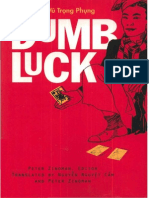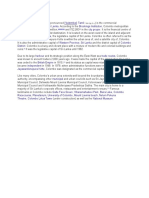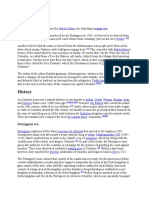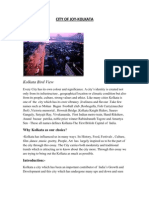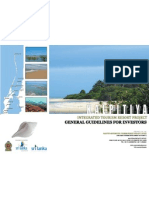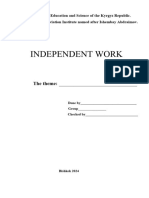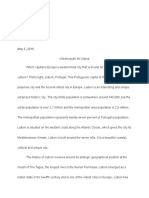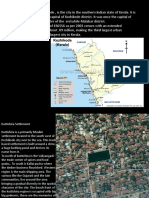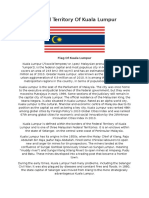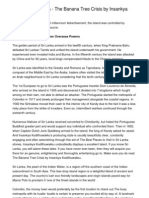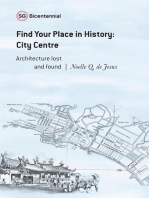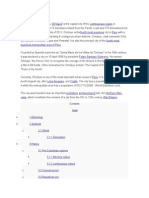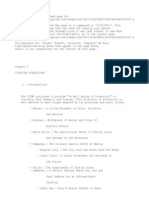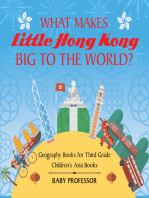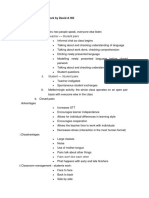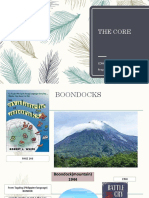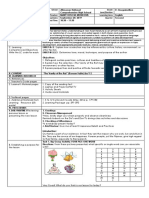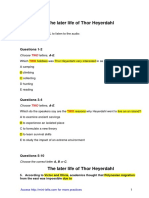Colombo
Colombo
Uploaded by
Jec SalacOriginal Description:
Copyright
Available Formats
Share this document
Did you find this document useful?
Is this content inappropriate?
Report this DocumentCopyright:
Available Formats
Colombo
Colombo
Uploaded by
Jec SalacCopyright:
Available Formats
Pabillaran, Jecthel C.
BSA - II
Colombo is the largest city and former capital of Sri Lanka. It is located on the west
coast of the island and adjacent to Sri Jayawardenapura Kotte, the capital. Colombo is a busy
and vibrant city with a mixture of modern life and colonial buildings and ruins and a city
population of 647,100. The Colombo Metropolitan Region, defined by the districts
of Colombo,Gampaha and Kalutara, has an estimated population of 5,648,000, and covers an
area of 3,694.20 km².
Due to its large harbour and its strategic position along the East-West sea trade routes,
Colombo was known to ancient traders 2,000 years ago. However it was only made the capital
of the island when Sri Lanka was ceded to the British Empire in 1815, and its status as capital
was retained when the nation became independent in 1948. In 1978, when administrative
functions were moved to Sri Jayawardenepura Kotte, Colombo was designated as the
commercial capital of Sri Lanka.
History. As Colombo possesses a natural harbor, it was known to Romans, Arabs, and
Chinese traders over 2,000 years ago. Traveller Ibn Batuta who visited the island in the 14th
century, referred to it as Kalanpu. Arab Muslims whose prime interests were trade, began to
settle in Colombo around the 8th century AD mostly because the port helped their business and
controlled much of the trade between the Sinhalesekingdoms and the outside world. Their
descendants now comprise the local Sri Lankan Moor community.
. Like many cities, Colombo's urban area extends well beyond the boundaries of a single local
authority, encompassing other Municipal and Urban Councils. The main city is home to a
majority of Sri Lanka's corporate offices, restaurants and entertainment venues.[6] Famous
landmarks in Colombo include the Galle Face Green, theViharamahadevi Park as well as the
National Museum.
Demographics. Colombo is a multi-ethnic, multi-cultural city. The population of Colombo is a mix
of numerous ethnic groups, mainly Sinhalese, Moors and Tamils. There are also small
communities of people with Chinese, Portuguese, Dutch, Malay and Indian origins living in the
city, as well as numerous European expatriates. Colombo is the most populous city in Sri
Lanka, with 642,163 people living within the city limits.
National capital. Colombo was the capital of the coastal areas controlled by the Portuguese,
Dutch and the British from the 1700s to the 1815 when the British gained control of the
entire island following the Kandian convention. From then until the 1980s the national
capital of the island was Colombo.
Economy. The great majority of Sri Lankan corporations have their head offices in Colombo.
Some of the industries include chemicals, textiles, glass, cement, leather goods, furniture, and
jewellery. In the city centre is located South Asia's second tallest building - The World Trade
Centre. The 40 story Twin Tower complex is the centre of important commercial establishments,
situated in the Fort district, the city's nerve center. Right outside the Fort area is Pettahwhich is
derived from the Sinhalese word pita which means out or outside as it is outside theFort.
Culture. Colombo's most beautiful festival is the celebration of Buddha's Birth, Enlightenment
and Death all falling on the same day.[50] In Sinhala this is known as Vesak.[50] During this
festival, much of the city is decorated with lanterns, lights and special displays of light(known
as Thoran). The festival falls in mid May and lasts a week when many Sri Lankans visit the city
to see the lantern competitions and decorations. During this week people distribute, rice, drinks
and various other food items for free in places what is known as Dunsal which means charity
place. These Dunsal are popular amongst visitors from the suburbs.
You might also like
- Dumb Luck - Vu Trong PhungDocument193 pagesDumb Luck - Vu Trong PhungJ T100% (5)
- Welcome To Hong KongDocument32 pagesWelcome To Hong KongStijn van BoxtelNoch keine Bewertungen
- Iloilo Heritage StructuresDocument35 pagesIloilo Heritage StructuresEdwin GalvezNoch keine Bewertungen
- Frankfinn Travel AssignmentDocument48 pagesFrankfinn Travel AssignmentNidhin Dadu40% (10)
- ColomboDocument1 pageColomboMaheshaSisirakumaraKulasekaraNoch keine Bewertungen
- Chapter Four 4.1 Introduction of Selected AreaDocument21 pagesChapter Four 4.1 Introduction of Selected AreaAmlan Kumar SahuNoch keine Bewertungen
- Sightseeing: Colombo HotelsDocument4 pagesSightseeing: Colombo HotelsUtpal SahaNoch keine Bewertungen
- Attractions: Beira Lake Slave IslandDocument3 pagesAttractions: Beira Lake Slave IslandAnosh IsmailNoch keine Bewertungen
- Port of Colombo: Coordinates Un/LocodeDocument15 pagesPort of Colombo: Coordinates Un/LocodeKamrul Alam TitobNoch keine Bewertungen
- Melaka and George TownDocument4 pagesMelaka and George TownAnggihsiyahNoch keine Bewertungen
- Kolkata: Mughal SuzeraintyDocument3 pagesKolkata: Mughal SuzeraintyMonirul IslamNoch keine Bewertungen
- Kotahena, Architectural Site AnalysisDocument38 pagesKotahena, Architectural Site AnalysisTharusha MunasingheNoch keine Bewertungen
- Canada Toronto: L'artillerieDocument5 pagesCanada Toronto: L'artillerieala cuiumjuNoch keine Bewertungen
- Stephen House BBD KolkataDocument21 pagesStephen House BBD KolkataSonali GurungNoch keine Bewertungen
- Etymology: Dutch Ceylon Mango TreeDocument3 pagesEtymology: Dutch Ceylon Mango TreeAnosh IsmailNoch keine Bewertungen
- Floating Markets in ThailandDocument3 pagesFloating Markets in Thailandpratik patelNoch keine Bewertungen
- Republic of The PhilippinesDocument8 pagesRepublic of The PhilippinesAgostinho TaylorNoch keine Bewertungen
- 4 Cid 11 HattonDocument30 pages4 Cid 11 HattonYathusayera SelvarajahNoch keine Bewertungen
- BerbaraDocument2 pagesBerbarabimiti5096Noch keine Bewertungen
- History of Kolkata - Evolution of The City - HolidifyDocument3 pagesHistory of Kolkata - Evolution of The City - HolidifyPrarthana roy RNoch keine Bewertungen
- City of JoyDocument11 pagesCity of JoyRishi Raj100% (1)
- Amsterdam: NetherlandsDocument10 pagesAmsterdam: NetherlandsFunto TofunNoch keine Bewertungen
- General Guidelines For InvestorsDocument46 pagesGeneral Guidelines For InvestorsHarish LakshminarayananNoch keine Bewertungen
- Exampl of IWDocument19 pagesExampl of IWСапар МурзакуловNoch keine Bewertungen
- Activity 4Document8 pagesActivity 4khelxoNoch keine Bewertungen
- Geography Part 1Document12 pagesGeography Part 1breshnaimran321Noch keine Bewertungen
- Amy E Orgeron GEOG 4356 DR StraitDocument9 pagesAmy E Orgeron GEOG 4356 DR StraitAmy OrgeronNoch keine Bewertungen
- Kolkata - Urban SettlementsDocument7 pagesKolkata - Urban SettlementsMathiyarasiNoch keine Bewertungen
- London As A Global MetropolisDocument2 pagesLondon As A Global MetropolisViktória OláhNoch keine Bewertungen
- Bangkok, Thai Krung Thep, City, Capital, and Chief Port ofDocument17 pagesBangkok, Thai Krung Thep, City, Capital, and Chief Port ofBoracu BoracuNoch keine Bewertungen
- Lisbon Travel Guide: A Comprehensive Guide to Lisbon, PortugalFrom EverandLisbon Travel Guide: A Comprehensive Guide to Lisbon, PortugalNoch keine Bewertungen
- I. Brief Profile of The City: Comprehensive Land Use Plan Volume IDocument131 pagesI. Brief Profile of The City: Comprehensive Land Use Plan Volume IZara DesignNoch keine Bewertungen
- Kutti ChiraDocument10 pagesKutti ChiraRenjithSukumaranKSNoch keine Bewertungen
- The Global CityDocument48 pagesThe Global CityMarc Loui RiveroNoch keine Bewertungen
- Colonial Architectural Heritage in BengalDocument14 pagesColonial Architectural Heritage in BengalYoshowant PurohitNoch keine Bewertungen
- Lal-Lo Municipal Tourism Development Plan (2015 - 2020: 17545.htmlDocument9 pagesLal-Lo Municipal Tourism Development Plan (2015 - 2020: 17545.htmlRj FelicisimoNoch keine Bewertungen
- Federal Territory of Kuala LumpurDocument3 pagesFederal Territory of Kuala Lumpurlucinda_johannesNoch keine Bewertungen
- History of Sri Lanka.20121030.122935Document2 pagesHistory of Sri Lanka.20121030.122935anon_368648305Noch keine Bewertungen
- Find Your Place in History - City Centre: Architecture Lost and Found: Singapore BicentennialFrom EverandFind Your Place in History - City Centre: Architecture Lost and Found: Singapore BicentennialNoch keine Bewertungen
- Singapore Seaport: HistoryDocument3 pagesSingapore Seaport: HistoryMd. Asif ChowdhuryNoch keine Bewertungen
- History: Caloocan CityDocument29 pagesHistory: Caloocan CityXyraine Razon100% (1)
- Brief History & Heritage PreservationDocument62 pagesBrief History & Heritage PreservationKing ErlanoNoch keine Bewertungen
- Referat EnglezaDocument3 pagesReferat EnglezaAlex DumitrescuNoch keine Bewertungen
- Location Information BookletDocument8 pagesLocation Information Bookletapi-291150883Noch keine Bewertungen
- Moquegua TourismDocument2 pagesMoquegua TourismArianna SaudNoch keine Bewertungen
- Brosur Heritage InggrisDocument23 pagesBrosur Heritage InggrisdevlinmcgNoch keine Bewertungen
- Chiclayo (: La Victoria, Pomalca, Reque and Pimentel It Is Also The Principal City of TheDocument6 pagesChiclayo (: La Victoria, Pomalca, Reque and Pimentel It Is Also The Principal City of TheJansh JalixtoNoch keine Bewertungen
- Tourism AttractionDocument67 pagesTourism AttractionTem YuNoch keine Bewertungen
- National Capital RegionDocument183 pagesNational Capital RegionEmmanuel HugoNoch keine Bewertungen
- The Koana IslandsDocument18 pagesThe Koana IslandsazraelstrossNoch keine Bewertungen
- London: Sinelnyk Sophia 7-BDocument6 pagesLondon: Sinelnyk Sophia 7-BSopfia SinelnykNoch keine Bewertungen
- New York CityDocument3 pagesNew York CityAlejandro AriasNoch keine Bewertungen
- CIty Island - Host BrochureDocument73 pagesCIty Island - Host Brochurejll_vanessachanNoch keine Bewertungen
- Central Market, Kuala Lumpur 1.1 Central MarketDocument14 pagesCentral Market, Kuala Lumpur 1.1 Central MarketHanaAnuarNoch keine Bewertungen
- Port of Colombo 14-25Document12 pagesPort of Colombo 14-25PrashanthMNairNoch keine Bewertungen
- Guide To Kuala LumpurDocument16 pagesGuide To Kuala LumpurcmooresNoch keine Bewertungen
- Arab-Norman Palermo and The Cathedral Churches of Cefalù and MonrealeDocument1 pageArab-Norman Palermo and The Cathedral Churches of Cefalù and MonrealekjlkjnNoch keine Bewertungen
- 05 - Chapter 2Document23 pages05 - Chapter 2Debdeep RayNoch keine Bewertungen
- Soal DescriptiveDocument5 pagesSoal Descriptivesulis ningrumNoch keine Bewertungen
- Internal and External Trade: Example, Nikayasangrhay and Inscription of Nissanka Malla - Show in Polonnaruwa PeriodDocument4 pagesInternal and External Trade: Example, Nikayasangrhay and Inscription of Nissanka Malla - Show in Polonnaruwa PeriodDileesha WeliwaththaNoch keine Bewertungen
- What Makes Little Hong Kong Big to the World? Geography Books for Third Grade | Children's Asia BooksFrom EverandWhat Makes Little Hong Kong Big to the World? Geography Books for Third Grade | Children's Asia BooksNoch keine Bewertungen
- Courtship: / PanliligawDocument31 pagesCourtship: / PanliligawJelo MasiclatNoch keine Bewertungen
- Ignat BednarikDocument3 pagesIgnat BednarikAndrew G. SalcedoNoch keine Bewertungen
- A Question of Priority - Revisiting The Bha Maha-Dandin Debate Yigal BronnerDocument52 pagesA Question of Priority - Revisiting The Bha Maha-Dandin Debate Yigal BronnerSahitya Nirmanakaranaya Sahitya NirmanakaranayaNoch keine Bewertungen
- Resumo Esquema Do Texto "Pairwork and Groupwork", de David A HillDocument2 pagesResumo Esquema Do Texto "Pairwork and Groupwork", de David A HillCPatricioNoch keine Bewertungen
- Types of SpeechDocument25 pagesTypes of SpeechGianNoch keine Bewertungen
- "Ignited Minds: Unleashing The Power Within India", by APJ Abdul Kalam, Viking (Penguin Books India), 2002, Rs. 250Document3 pages"Ignited Minds: Unleashing The Power Within India", by APJ Abdul Kalam, Viking (Penguin Books India), 2002, Rs. 250Pasham Vishnu Vardhan GoudNoch keine Bewertungen
- LFR LetterDocument1 pageLFR LettercunylawblogNoch keine Bewertungen
- Europass Language PassportDocument2 pagesEuropass Language Passportlaura_carreraNoch keine Bewertungen
- FINAL Project Tourism Marketing of Madhya PradeshDocument89 pagesFINAL Project Tourism Marketing of Madhya Pradeshankit kumar0% (1)
- Bilingual Lexicon StudyDocument9 pagesBilingual Lexicon StudyFatin FarhanaNoch keine Bewertungen
- SSS Presentation PDFDocument50 pagesSSS Presentation PDFEMMANUEL SSEWANKAMBO100% (2)
- Parental Level of Education and Students' Academic Ambition - A Case Study of Secondary Schools in Laikipia County, KenyaDocument7 pagesParental Level of Education and Students' Academic Ambition - A Case Study of Secondary Schools in Laikipia County, KenyaEas PublisherNoch keine Bewertungen
- Class OrientationDocument26 pagesClass OrientationJohn Paul LaraNoch keine Bewertungen
- (Download PDF) Invitation To World Religions 3Rd Edition Jeffrey Brodd Online Ebook All Chapter PDFDocument42 pages(Download PDF) Invitation To World Religions 3Rd Edition Jeffrey Brodd Online Ebook All Chapter PDFmario.favuzza740100% (12)
- BoondokDocument20 pagesBoondokangelicaNoch keine Bewertungen
- Jawaharlal Nehru's AchievementDocument1 pageJawaharlal Nehru's AchievementDibyendu Twipz BiswasNoch keine Bewertungen
- COT The Vanity of The Rat 2nd QDocument5 pagesCOT The Vanity of The Rat 2nd QJoscelle Joyce RiveraNoch keine Bewertungen
- Speech Styles QuizDocument2 pagesSpeech Styles QuizIvyNoch keine Bewertungen
- A-R Editions Online Music Anthology: 1600 Aspen Commons, Suite 100, Middleton, WI 53562Document1 pageA-R Editions Online Music Anthology: 1600 Aspen Commons, Suite 100, Middleton, WI 53562Maria del AmorNoch keine Bewertungen
- Oacs Social Studies Unit AdaptationDocument14 pagesOacs Social Studies Unit Adaptationapi-315748663Noch keine Bewertungen
- English 360 Portfolio Rubric For Revised DocumentsDocument3 pagesEnglish 360 Portfolio Rubric For Revised Documentsapi-302628707Noch keine Bewertungen
- Teaching Kids Resource - Homes and FurnitureDocument3 pagesTeaching Kids Resource - Homes and FurnitureSimona Siki PetkovskaNoch keine Bewertungen
- Revised Assignment in Cfe - DuldulaoDocument2 pagesRevised Assignment in Cfe - DuldulaoArfiele ramiscalNoch keine Bewertungen
- Sample IGCSE TestsDocument57 pagesSample IGCSE Testssahara1999_991596100% (7)
- A Decolate Place For Defiant PeopleDocument271 pagesA Decolate Place For Defiant PeopleGarvey Lives100% (1)
- Nairne PersonalstatementprofessionalphilosophyDocument10 pagesNairne Personalstatementprofessionalphilosophyapi-283210192Noch keine Bewertungen
- Learning and Development ANNEX B RevisedDocument22 pagesLearning and Development ANNEX B RevisedloretaNoch keine Bewertungen
- The Later Life of Thor HeyerdahlDocument5 pagesThe Later Life of Thor HeyerdahlkakakakakNoch keine Bewertungen
- Product: Adolescence Magazine Themes: Plans For Front Cover(s) Photo-ShootDocument6 pagesProduct: Adolescence Magazine Themes: Plans For Front Cover(s) Photo-ShootDonnell WelchNoch keine Bewertungen
